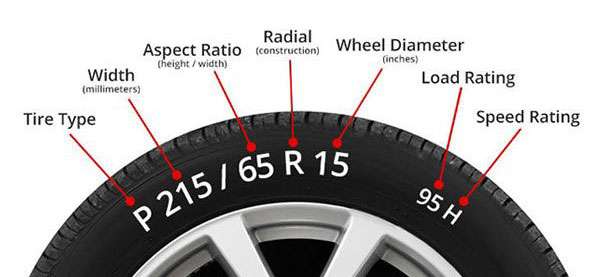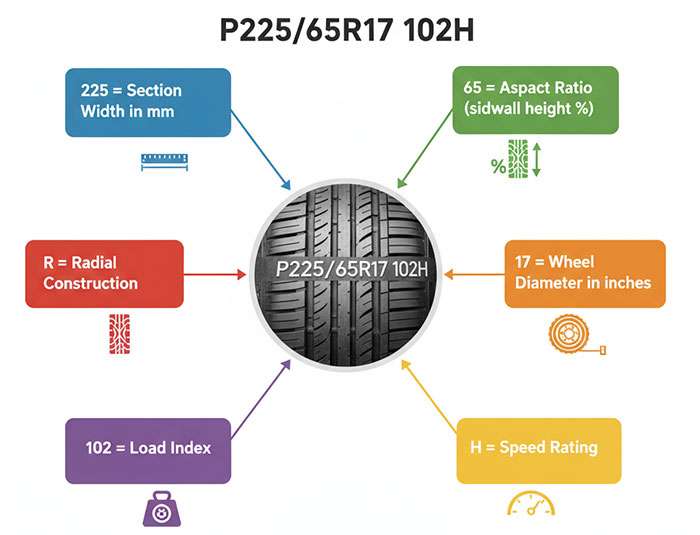
Looking at those numbers stamped on your tire's sidewall can feel like decoding a secret message. The diameter of a standard tire appears in inches as part of the tire size code. A tire marked 33 x 12.5 R15 measures 33 inches in diameter, 12.5 inches wide, and fits a 15-inch wheel.
Tire size codes follow specific measurement standards that reveal everything about your tire's dimensions and capabilities. The diameter directly impacts your speedometer readings and how your vehicle handles on the road. Different tire formats present this information in various ways - a 165/60R12 tire measures 19.8 inches in total diameter, while a 33X10.50R15 spans 33 inches. Most tire sizes start with a letter showing the tire class, followed by a three-digit width measurement in millimeters.
Getting familiar with these codes helps you make smart decisions when shopping for replacement tires. Each number and letter tells a specific story about fitment, performance, and safety. This guide breaks down exactly how to read tire measurements and explains what each component means for your vehicle's performance.
Those letters and numbers on your tire sidewall follow a specific pattern that reveals exact specifications about your tire's capabilities. Each component tells you something different about construction, size, and performance.
The opening letter identifies what type of vehicle the tire serves. "P" designates passenger vehicle tires for cars, SUVs, and light-duty pickup trucks. "LT" marks light truck tires built to handle heavy loads and towing demands. "ST" appears on special trailer tires, while "T" indicates temporary spare tires. When no letter starts the code, you're looking at a Euro-metric tire that follows European sizing standards.
The three-digit number after the class letter shows the tire's width from sidewall to sidewall in millimeters. This measurement captures the tire at its widest point. A tire marked "215" measures exactly 215mm wide, which equals approximately 8.5 inches.
Following the width comes a forward slash and a two-digit percentage that shows sidewall height relative to tire width. A "65" aspect ratio means the sidewall height equals 65% of the tire's width. Performance tires typically use lower ratios like 40 or 45 for better handling, while comfort-focused tires use higher ratios for a smoother ride.
A single letter indicates how the tire is built internally. "R" stands for radial construction, where fabric cords run perpendicular to the centerline. Radial tires deliver better fuel economy, superior traction, and extended tread life. "D" represents diagonal construction with crisscrossing plies at 30-45 degree angles. "B" identifies bias-belted tires that include an additional stabilizer layer.
The final number specifies the wheel diameter in inches that the tire fits. This measurement ensures you select tires that match your vehicle's wheels perfectly.
When you put it all together, P215/65R16 means: passenger tire, 215mm wide, sidewall height 65% of width, radial construction, designed for 16-inch wheels.

Those final numbers and letters following your tire's size code contain critical safety information. The load index and speed rating determine your tire's weight capacity and maximum safe speed - specifications that directly affect your vehicle's safety and performance.
The load index appears as a numerical code, typically ranging from 75-100 for passenger cars, that indicates the maximum weight each tire can safely support when properly inflated. This number doesn't show actual pounds but corresponds to a standardized chart. A load index of 95 means each tire handles 1,521 pounds, while 100 indicates a 1,764-pound capacity.
Look for this two or three-digit number just before the final letter in your tire's size code. Light truck tires display dual load indexes (such as 120/116), where the second number shows capacity for dual rear wheel setups.
The speed rating follows immediately after the load index as a single letter. This rating shows the maximum speed your tire can maintain safely over extended periods under ideal conditions. Common speed ratings include:
| Rating | Maximum Speed |
|---|---|
| S | 112 mph |
| T | 118 mph |
| H | 130 mph |
| V | 149 mph |
| W | 168 mph |
| Y | 186 mph |
The "H" rating breaks alphabetical order - positioned between "U" and "V" - due to early European rating system conventions.
Exceeding your tire's load capacity or speed rating creates serious safety risks. Overloaded tires wear faster and can suffer catastrophic blowouts in extreme cases. Speed ratings represent laboratory-tested limits under controlled conditions, not real-world driving scenarios.
Always match or exceed your vehicle manufacturer's recommended load and speed ratings when buying replacement tires. When mixing tires with different ratings, your vehicle's safe limits drop to match the lowest-rated tire. We recommend checking these specifications carefully - your safety depends on proper tire selection for your specific vehicle and driving needs.

Finding tire size information on your vehicle doesn't require a treasure hunt. These specifications appear in multiple locations, each serving as a reliable reference point for your tire shopping needs.
Your owner's manual contains the manufacturer-recommended tire sizes. You can also locate this information on the driver's side door jamb, inside the glove box door, or within your gas tank hatch. The tire sidewall itself displays the most prominent version - look for the largest sequence of numbers and letters molded into the rubber.
Take a common tire size like 205/65R16 95H. The "205" shows the width in millimeters from sidewall to sidewall. The "65" represents the aspect ratio - this tire's height equals 65% of its width. The "R" indicates radial construction, which is the industry standard today. The "16" tells you this tire fits a 16-inch wheel. The final "95H" combines the load index (95 equals 1,521 pounds capacity per tire) with the speed rating (H means 130 mph maximum speed).
Metric sizes like 205/65R16 use millimeters for width and include aspect ratio percentages. Flotation sizes such as 33x12.50R17LT measure everything in inches. The first number in flotation sizing represents total diameter (33 inches), while the second shows width (12.50 inches). This difference matters when shopping for replacements. For expert guidance on finding your perfect tire fit, visit Performance Plus Tire, offering extensive selection and professional advice.
Swapping your factory tires for a different size changes more than your vehicle's looks. These modifications affect key performance areas that directly impact your daily driving experience.
Your speedometer calibration depends on the rolling diameter of your original tires. Larger tires make your speedometer show slower speeds than you're actually traveling. With tires just 3% bigger than stock, your gauge might read 60 mph while you're really doing 63.3 mph. Smaller tires create the opposite problem - your speedometer reads faster than your true speed. These tire size changes also throw off your odometer readings, which can mess up your maintenance schedule timing.
Tire size directly affects how much gas you use and how your vehicle rides. Wider, larger tires create more rolling resistance, forcing your engine to work harder and burn more fuel. Highway cruising might see some efficiency gains with larger tires once you're up to speed.
Comfort takes a hit when you go with larger wheels and low-profile tires. Less sidewall means less cushioning to absorb bumps and road imperfections. Heavier wheels also add unsprung weight, reducing your suspension's ability to smooth out the ride.
The biggest immediate problem with oversized tires is rubbing against your vehicle's components. Too-large tires can hit fenders, wheel wells, struts, or suspension parts. Watch for warning signs like unusual tire wear, burning rubber smells, or scraping sounds when turning or hitting bumps.
Several factors cause rubbing problems: wrong wheel offset, worn suspension parts, or a lowered ride height. Solutions include wheel spacers, fender modifications, or simply selecting the right tire size that maintains proper clearance. The smart approach is choosing sizes that avoid these headaches entirely.
Mastering tire size codes puts you in control of your vehicle's performance and safety decisions. We've decoded the sidewall markings that reveal critical information about diameter, width, construction, and load capabilities.
Tire diameter measured in inches directly affects speedometer accuracy, fuel efficiency, and ride quality. Sticking with manufacturer specifications prevents handling issues and clearance problems that can compromise your vehicle's performance.
The load index and speed ratings represent essential safety limits that protect you from dangerous tire failures. These numbers aren't suggestions - they're engineered specifications that should never be exceeded, especially during challenging driving conditions.
Changing tire sizes offers visual appeal and performance benefits, but requires careful consideration of the trade-offs. Larger tires can improve ground clearance and appearance while potentially reducing fuel economy and creating fitment challenges.
At Performance Plus Tire, we offer expert guidance and an extensive selection to help you find the perfect tire fit for your specific vehicle. Our knowledgeable team understands that proper tire selection affects every aspect of your driving experience.
Your tires are the only connection between your vehicle and the road. Armed with this knowledge, you can confidently select tires that deliver the performance, safety, and value you need. The diameter isn't just a number - it's the foundation of your vehicle's capabilities.
Understanding tire size codes is essential for vehicle safety and performance, helping you make informed decisions about replacements and upgrades.
Tire diameter is shown in inches: Standard tires display diameter as the final number (e.g., 16 in P215/65R16), indicating the wheel size the tire fits.
Decode the sidewall formula: Width (mm) / Aspect Ratio % + Construction Type + Wheel Diameter (inches) + Load Index + Speed Rating reveals all specifications.
Load index and speed ratings ensure safety: These numbers indicate maximum weight capacity and speed limits - never exceed manufacturer recommendations to prevent dangerous blowouts.
Changing tire size affects performance: Larger tires can cause speedometer inaccuracy, reduced fuel economy, harsher ride quality, and potential rubbing against vehicle components.
Find tire info in multiple locations: Check the sidewall, owner's manual, driver's door jamb, or glove box for manufacturer-recommended specifications before purchasing replacements.
Remember that your tires are the only contact point between your vehicle and the road, making proper sizing crucial for optimal safety, handling, and fuel efficiency.
You can find the tire diameter by looking at the last number in the tire size code on the sidewall. For example, in P215/65R16, the "16" indicates a 16-inch wheel diameter. Alternatively, check your vehicle's owner's manual or the driver's side door jamb for this information.
The aspect ratio is the two-digit number after the slash in a tire size code. It represents the tire's height as a percentage of its width. For instance, in 205/65R16, the "65" means the tire's height is 65% of its width. Lower ratios typically indicate sportier tires, while higher ratios suggest more comfort-oriented designs.
Changing tire size can impact speedometer accuracy, fuel economy, and ride comfort. Larger tires may cause your speedometer to show slower speeds than actual, potentially increase fuel consumption, and could result in a harsher ride. Additionally, oversized tires might cause fitment issues, rubbing against vehicle components.
The load index is a numerical code indicating how much weight each tire can safely carry when properly inflated. The speed rating, represented by a letter, shows the maximum speed a tire can safely maintain under ideal conditions. Both are crucial for safety and should match or exceed your vehicle manufacturer's recommendations.
While it's possible to use a different tire size, it's generally best to stick with the manufacturer's recommendations. Changing tire size can affect your vehicle's handling, speedometer accuracy, and clearance. If you do choose a different size, ensure it maintains proper load capacity and speed rating, and consider potential impacts on performance and safety.